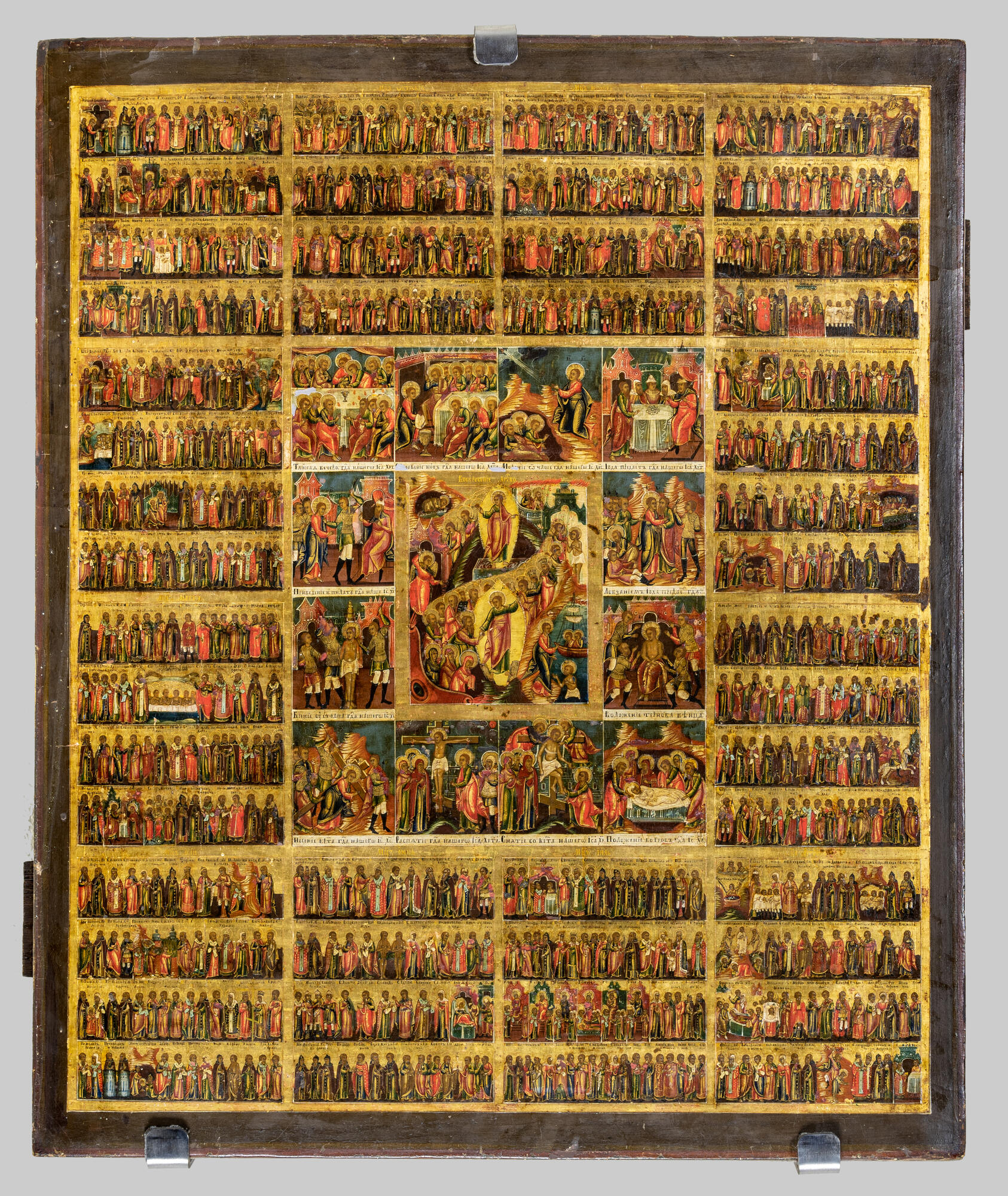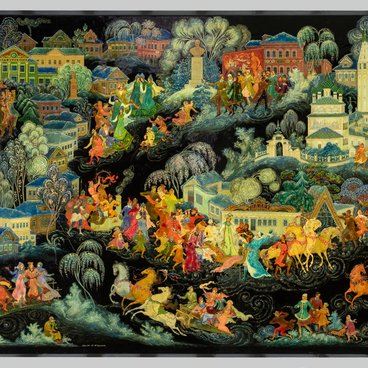The icon of the 12-Month Menaion was painted on a solid cypress board in the 1890s. The inscription in dark ink on the back reads: ‘The work of the Palekh craftsmen, 1890s…’
The author of the inscription, Nikolai Zinoviev, also writes that the landscapes and dresses were painted by Mikhail Zinoviev from Diaghilev, the inscriptions were created by Vasily Karpenkov from Kovshovo, and the faces were painted by Vasily Markichev from Palekh (it was customary for several artists to work on a single icon simultaneously: one, the ‘face painter’, painted only the exposed parts of the body and the face of the saint, while the other, the ‘dress painter’, worked on all other details). Yet the jury is still out on the identity of the authors, as the inscription was made much later than the icon itself.
The Menaion is a calendar icon that contains the dates of important Christian holidays. Each month is represented by four lines, which are combined into a separate border scene.
The centerpiece consists of two scenes at once: they do not belong to the calendar and depict the Resurrection of Jesus and the Harrowing of Hell. Both scenes show the Savior in full length, surrounded by the radiance of an oval halo. In the upper scene, he is standing in a tomb. In the lower scene, he is defying the gates of hell. The entrance to hell is depicted in the form of a trefoil arch topped with two pincers. The artist painted it to the right of the upper figure of Jesus. One of the angels is opening the entrance. Below, the forefathers and righteous wives are emerging from the beast-like mouth of hell. To the left of Jesus, a line of righteous souls is ascending to Heaven.
The centerpiece is surrounded by scenes from the Passion of Jesus. Their names are written in black on white plaques.
The other twelve scenes are dedicated to the twelve months of the year. The scenes must be read line by line, from left to right. Interestingly, a year in the Menaion begins in September. This is because in Russia, September had for a long time been considered the first month of the year based on the Alexandrian calendar. Many Old Believers have retained this tradition even after 1700, when Peter the Great ordered to start the year on January 1.
Many Christian holidays are dedicated to Russian and Byzantine saints. The artists depicted the figures of these saints under a certain date of the month. Sometimes they added themed elements to the images of people. Rocks, grass, trees, and other elements of the landscape were depicted in a typical icon-painting style. Above the miniatures, the artists placed the names of the holidays and the names of the saints, writing them in black paint.
The faces of the saints are painted according to the traditional technique: first, a dark olive layer, and then dark brown ocher. The artists used black pigment for the facial features (eyes, noses, lips). They also applied dots and strokes of white paint to create highlights. The folds of the robes are outlined with special golden paint. It is made of real gold ground into a fine powder.
The icon was donated to the museum by LyubOv AndrEeva-DelmAs in 1965.
The author of the inscription, Nikolai Zinoviev, also writes that the landscapes and dresses were painted by Mikhail Zinoviev from Diaghilev, the inscriptions were created by Vasily Karpenkov from Kovshovo, and the faces were painted by Vasily Markichev from Palekh (it was customary for several artists to work on a single icon simultaneously: one, the ‘face painter’, painted only the exposed parts of the body and the face of the saint, while the other, the ‘dress painter’, worked on all other details). Yet the jury is still out on the identity of the authors, as the inscription was made much later than the icon itself.
The Menaion is a calendar icon that contains the dates of important Christian holidays. Each month is represented by four lines, which are combined into a separate border scene.
The centerpiece consists of two scenes at once: they do not belong to the calendar and depict the Resurrection of Jesus and the Harrowing of Hell. Both scenes show the Savior in full length, surrounded by the radiance of an oval halo. In the upper scene, he is standing in a tomb. In the lower scene, he is defying the gates of hell. The entrance to hell is depicted in the form of a trefoil arch topped with two pincers. The artist painted it to the right of the upper figure of Jesus. One of the angels is opening the entrance. Below, the forefathers and righteous wives are emerging from the beast-like mouth of hell. To the left of Jesus, a line of righteous souls is ascending to Heaven.
The centerpiece is surrounded by scenes from the Passion of Jesus. Their names are written in black on white plaques.
The other twelve scenes are dedicated to the twelve months of the year. The scenes must be read line by line, from left to right. Interestingly, a year in the Menaion begins in September. This is because in Russia, September had for a long time been considered the first month of the year based on the Alexandrian calendar. Many Old Believers have retained this tradition even after 1700, when Peter the Great ordered to start the year on January 1.
Many Christian holidays are dedicated to Russian and Byzantine saints. The artists depicted the figures of these saints under a certain date of the month. Sometimes they added themed elements to the images of people. Rocks, grass, trees, and other elements of the landscape were depicted in a typical icon-painting style. Above the miniatures, the artists placed the names of the holidays and the names of the saints, writing them in black paint.
The faces of the saints are painted according to the traditional technique: first, a dark olive layer, and then dark brown ocher. The artists used black pigment for the facial features (eyes, noses, lips). They also applied dots and strokes of white paint to create highlights. The folds of the robes are outlined with special golden paint. It is made of real gold ground into a fine powder.
The icon was donated to the museum by LyubOv AndrEeva-DelmAs in 1965.



